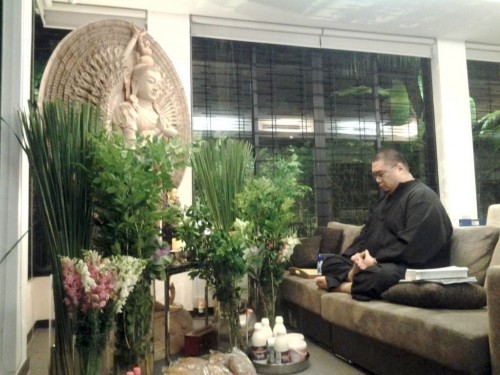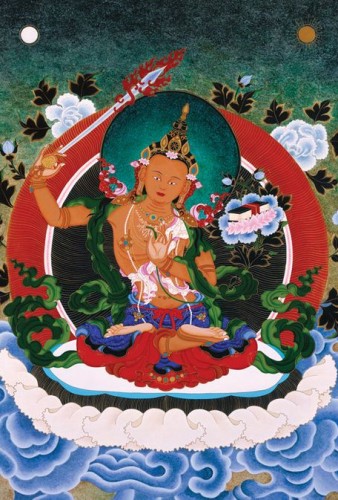Childhood Buddhas
20 Sep
Just a few days ago, I was with Rinpoche sitting in front of his Manjushri altar. As the picture above shows, the dominating icon is this large wooden statue of Manjushri with a thousand arms fanning out around him in a complete circle. There were of course various other smaller forms of Manjushri and exotic Tantric imagery sitting amidst neatly arranged silver bowls and electric candles on crystal stands. The altar is always replete with flowers and various other offerings by many devoted students from across Kechara and the world over.
It was just Bryan, Joy, myself and Seng Piow in the room with Rinpoche. Rinpoche was in the midst of rearranging the offerings so everything is perfectly symmetrical. He told us that he wanted his altar perfect for Manjushri. Somehow, the conversation drifted to iconography and he asked us what we thought were his most favourite aspect of iconography. It was really late and I remember saying, “Something between Yamantaka and Heruka.” In the end, it was Seng Piow who nailed it when he said Manjushri’s sword. He said Manjushri’s sword and book was once the emblem of Rinpoche’s previous centre. With that, Rinpoche replied that it was indeed an old logo that Rinpoche had Irene register with the ROS for the old centre that Rinpoche used to managed in Malaysia prior to the formation of Kechara.
Then, Rinpoche turned to look at Manjushri and said that when he was young living in America, every Kalmyk family in New Jersey had a shrine. They would have various Buddhist icons on it. At home, he was not allowed to display any signs of devotion at his family shine but when his mother (foster) took him to his aunt’s for a visit, she would be too busy to mind him. So, he was able to spend quite a bit of time praying and admiring a beautiful 4-armed Chenrezig picture on the shrine. That image of Chenrezig was the most beautiful to Rinpoche but he has not seen it since. When he was young, he loved Chenrezig/ Avalokitehsvara a lot and would do a lot of meditations and rather complex visualisations on Chenrezig to invoke his compassion.
However, Rinpoche explained that he always had Manjushri in a very special place in his heart. He would recite Manjushri’s Gangloma praise daily and he would recite thousands of Manjushri’s mantras every day for practice. In the local temple that he went, he would make the normal beeline beginning with the Dalai Lama’s throne, the various Buddhas and he would make an extended prostration to Manjushri. At that time, he kept a beautiful picture of Manjushri with him all the time. This Manjushri was from a Dharma center in England that he had a student reproduce on canvas recently. The following picture of Manjushri is a faithful reproduction of this original one that he kept in his childhood.
Rinpoche loved this picture of Manjushri so much that he would sleep with the picture. He placed the picture on his heart and he covered it with his blanket. At that time, his foster parents had deep issues that was affecting his mother’s sanity. Although an affectionate and generous woman, she quickly degenerated into schizophrenia with many bouts of violent abuse and destructive behaviour particularly directed at him. This coupled with his parents disapproval of his innate spirituality that left him to languish in despair. He had prayed to Manjushri and with Manjushri by his heart, he downed pills. Fortunate for all us, Rinpoche didn’t die. So it seems that Manjushri was the main object of refuge and prayer in times of despair and difficulty. Since childhood, he had always kept an image of Manjushri near him till this day.
I have various other such childhood stories of Tsem Rinpoche in Tales My Lama Told Me.~ http://www.vajrasecrets.com/tales-my-lama-told-me







No comments yet